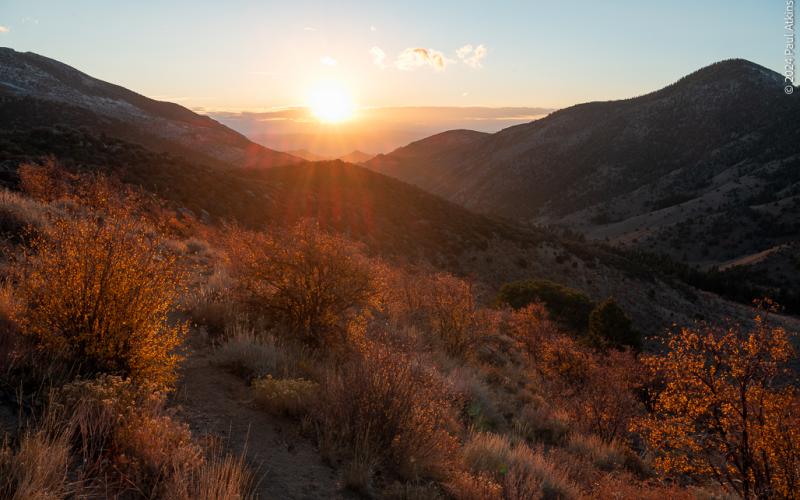Fired Great Basin National Park rangers back to work, but fears linger

Photo: Paul Atkinson, 2024 Great Basin National Park Artist-in-Residence
This article was published in The Nevada Independent by Indy Environment correspondent, Amy Alonzo
Each October, Great Basin National Park celebrates its birthday.
But last week, the park received an early gift.
Five park employees laid off in February — about 20 percent of the park’s staff — were rehired after a federal appeals court upheld a lower court’s decision directing President Donald Trump’s administration to rehire terminated federal workers.
The layoffs were part of the Trump administration’s effort to scale down the size of the federal government, including the National Park Service. But for the already understaffed Great Basin (which after the layoffs had less staff than it had two decades ago), the cuts led to reduced park services and concern among local officials who worried about the trickle-down effects on the local economy.
“If people don’t have confidence in travel or feel like we’re going into a recession and don’t come out and take vacations, that’s our hit,” said Kyle Horvath, White Pine County’s director of tourism. “If people aren’t traveling, we don’t have the money coming into room tax. That limits our ability to invest back in the community.”
Part of Great Basin’s appeal is its remoteness. An hour outside Ely, getting to the park requires a six-hour drive from Reno or a more than four-hour drive from Las Vegas.
Despite its remoteness, visitation at Great Basin has doubled over the last two decades, and the park now sees more than 140,000 visitors annually.
In 2023, the park’s 143,000 visitors contributed an estimated $15.4 million to the local economy.
“When you invest in national parks, you invest in economies in rural areas that often don’t have as many means to have a vibrant, thriving economy,” said Aviva O’Neil, executive director of the Great Basin National Park Foundation, the park’s official nonprofit partner.
Great Basin is the largest tourism draw in White Pine County, where two-thirds of taxable sales are generated by tourism — in 2023, taxable sales totaled $64.5 million. White Pine County reinvests 51 percent of the room tax it collects directly back into recreational infrastructure and events to attract tourists — a loop that cuts to the park could severely disrupt.
“If a person believes their national park experience may not be what they are looking for — that it may not include ranger-led programs, an opportunity for a Lehman Caves tour, telescope viewing, open campgrounds and clean bathrooms — they will be less likely to come to our area,” Horvath previously said. “That would be an enormous hit to our economy.”
'Still highly concerned’
Each year, thousands of tourists flock to Great Basin National Park to hike Wheeler Peak, the second-tallest mountain in Nevada, take advantage of the area’s dark skies for stargazing or view the park’s ancient bristlecone stands.
But it’s a feature tucked beneath the surface that’s among the park’s most popular attractions. Winding along for 2 miles underground, Lehman Caves is the largest known cave system in Nevada. Each year, the caves draw roughly 50,000 visitors, who book reservations well in advance to view its unique shield formations.
When the five employees were let go in February, the cuts were crippling to the park, which already had eight vacant positions, O’Neil said.
“The scary thing with these recent layoffs is that most of them are interpretive rangers, and those are the ones leading the cave tours and providing the service everyone comes for,” Horvath said.
With the staffing reduction, the park significantly reduced its number of cave tours, offering them only on a first-come, first-served basis hinging on daily staffing. Previously, the tours were offered via reservations that often sold out.
The park’s foundation temporarily rehired the five workers as foundation employees at a cost of $1,000 per person per week, O’Neil said. But, with only $25,000 to work with, that funding was set to expire soon before the court order brought the rangers back to work at the park’s two visitor centers and lead cave tours, as well as do maintenance work.
But there’s still a lot of uncertainty for the park and the communities that rely on it for tourism revenue heading into the summer, the park’s peak visitation months.
“Part of the story is how complicated it is to plan,” she said. “When you’re a national park, a lot of your planning happens in the spring [and] there’s still that kind of not really knowing.”
The park’s superintendent is on leave and the acting park superintendents did not return an email from The Nevada Independent.
Meanwhile, staff members are bracing for another round of reductions in force ordered by the administration.
“We are still highly concerned with staffing levels moving forward,” O’Neil said. “We know a reduction in force is in the works, but have no idea what that could mean for Great Basin National Park.”
Article from the Indy Environment: The Nevada Independent’s twice-monthly newsletter about environmental issues in Nevada.
